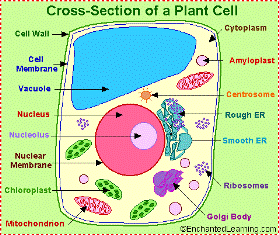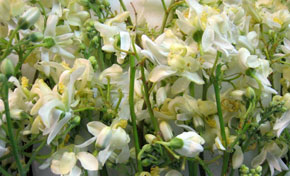Classification
Domain: Eukaryota
Cells contain a nucleus and membrane bound organelles.
Kingdom: Plantae - Plants
 The cells possess a cell wall made of cellulose
and contain chlorophyll and chloroplasts which allow the plant to
photosynthesize. It also possesses multicellularity and are
autotrophic because they use photosynthesis as a mean for acquiring
food. They also exhibit an alternation of generations, meaning they
posses both haploid and diploid phases throughout their lifecycles.
The cells possess a cell wall made of cellulose
and contain chlorophyll and chloroplasts which allow the plant to
photosynthesize. It also possesses multicellularity and are
autotrophic because they use photosynthesis as a mean for acquiring
food. They also exhibit an alternation of generations, meaning they
posses both haploid and diploid phases throughout their lifecycles.
Subkingdom: Tracheobionta - Vascular plants
It contains true vascular tissue such as xylem and phloem. Xylem is responsible for the transport of water throughout the plant. This occurs from the roots of the plant to the leaves. Phloem is responsible for the transports of sugar and nutrients (the plants food). This moves in the direction from the source to the sink. The source can either be the leaves which are going through photosynthesis or storage roots which hold nutrients during the cooler months. The sink can be the leaves of the plants or the roots.
Superdivision: Spermatophyta - Seed plants
Plants which reproduce via seeds and are heterosporous meaning it produces two types of spores that differ in both size and shape.
Division: Magnoliophyta - Flowering plants
Plants who have seeds which are enclosed in ovarian tissue, otherwise known as fruit.
Class: Magnoliopsida - Dicotyledons
Synonymous for eudicots or dicots. Dicots have a net-like leaf venation and produce flower parts in multiples of four or five. Dicots go through primary growth, which is lateral growth resulting from elongation of cells produced by the apical meristem , and secondary growth, growth outwards in girth resulting from vascular cambiums accumulating by connecting together.
Subclass: Dilleniidae
An advanced subclass compared to the Magnoliidae, but less advanced than the Asteridae. They are syncarpous, possessing united carpels, and polypetalous meaning the flower contains separated petals.
Order: Capparales
Order of flowering plants, including other families such as Tovariaceae, Capparaceae, Brassicaceae, and Resedaceae.
Family: Moringaceae - Horse-radish tree family
The Moringaceae family is characterized by the production of 3- valved fruit. It has parietal placentation which is (help). It is also characterized by elongated, non dehiscent berries and seeds.
Genus: Moringa Adans - Moringa
Trees which often exhibit a swollen trunk and roots that have a horseradish odor to them. Their flowers are bisexual and can be either actinomorphic or zygomorphic. Actinomorphic flowers are radially symmetrical meaning they have more than one line of symmetry. This is different from zygomorphic flowers which are bilaterally symmetric, meaning they have only on plane of symmetry.

Species: Moringa oleifera
M. oleifera is distinguished by its 12-18mm long tripinnate leaflets and its yellow or white petioles. The whole plant its self is medium in size. This unlike M. concanensis, the other common species in the Moringaceae family, which has petals with a red base or streaks, 15-30mm bipinnate leaflets, and is large in size.
Click here to check out the habitat of Moringa oleifera
